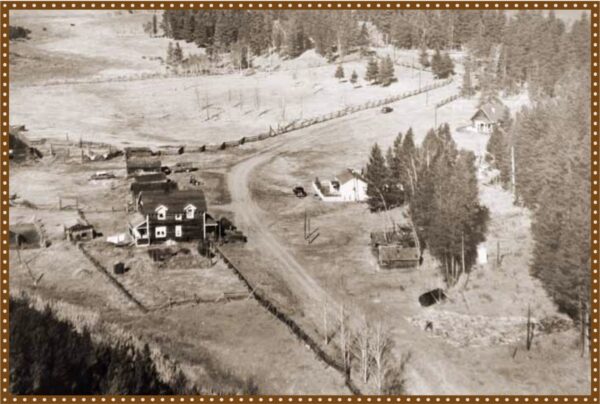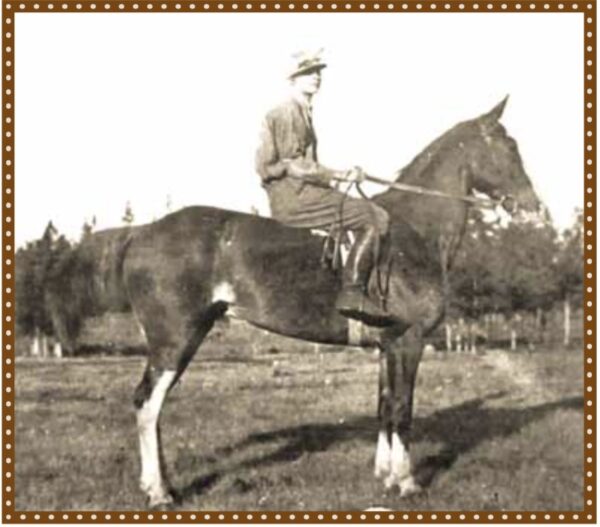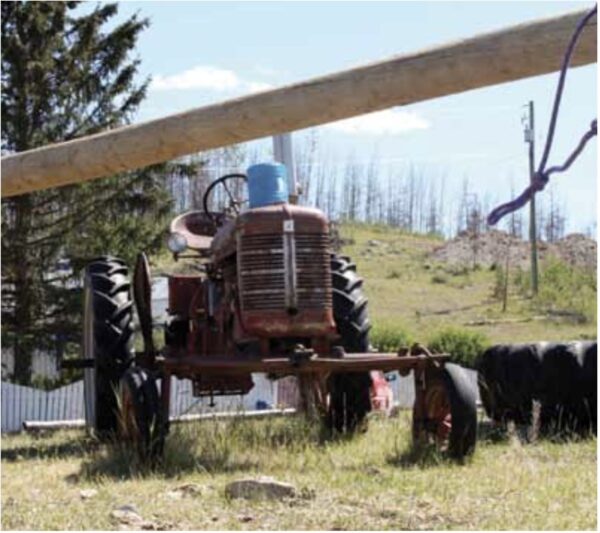Jack Cunningham Realized His Golden Opportunity
By Marguerite Meland
Many prospective gold miners travelled the B.C. interior along the Cariboo Wagon Road in the 1860’s – but road crew foreman Jack Cunningham found his treasure at Mile 74 of the fabled trail, where he built a ranch that stands to this day.

Still home to his descendants, the Cunningham ranch, north of Clinton, lies nestled in trees and blanketed by grasslands.
As the story goes, founder Jack was toiling with his road crew through the grasslands around the 70 Mile House (established in 1862), when he took an interest in the rugged beauty of the area. Four miles north of this small community, he took over an abandoned guest house and a quarter section of land, where he erected a two- storey, squared-log house next to the newly constructed road. He soon realized that a roadhouse situated at the 74 Mile of the Cariboo would make a fine place for freighters and other travellers to stay.
The Cariboo road stretched from Mile 0 at Lillooet to Alexandria, south of Quesnel. By 1920, motorized vehicles would bump along the road towards the gold fields. The Cunningham ranch proved a popular place for these weary travellers.

At the same time, Jack raised about 150 head of cattle and horses (his descendants still maintain a herd). Jack, unfortunately, died in 1910 – leaving it up to his busy wife Margaret to manage the outfit.
Margaret and Jack had four children: Norman, Rita, Ken and Margaret. Tragically, Ken died at the age of 12. While they were growing up, Margaret hired Frank Mills to run the ranch. During the Depression, Margaret supplemented the ranch’s income by turning the road- house into a guest house; she had rooms, cabins and hot meals for all her guests. A gifted hostess, she never turned a soul away.
By then, the ranch had stretched out to a half section of land and an 80-acre hay field. Cattle grazed on the nearby open range.
In the ’30s and ’40s, Margaret would take in young people from Vancouver and Victoria over the summers. Sometimes, up to 20 would show up for a chance to experience ranch work and help out.
This part of Cunningham ranch history involved my mother, Barbie, and her brother, Freddie. During summers of the late ’30s, she and Freddie were driven up from Victoria by their father, Edward Winslow. Later, I visited this ranch to meet the wonderful people my mom used to talk about.
Sure enough, every time I dropped in I was warmly welcomed. During these visits the Cunningham family would tell me about the Winslow kids and some of the history of their old homestead.
Barbie and Freddie jumped right in with the cowboys to herd and round up cattle and horses. Rita Cunningham took them under her wing. She, along with some of her extended family, taught my mom and uncle how to ride western and work as a ranch hand. Freddie fell in love with the place. With Rita’s help, he learned how to train horses. One horse of his, Warbucks, stood out. Freddie taught him more than just ranch work; he also raced him and did well at local racing events.

Sadly, Freddie was killed during the Second World War; the Cunninghams lovingly looked after Warbucks until the end.
Today, the ranch is ringed by generations of old corrals and the original barn as well as old guest houses. At 78 years young, Norman’s son, Bill, still works at the ranch. Bill’s son, Lee, and grandson, Wade Cunningham, also work there. They run about 160 head of Hereford and red and black Angus. The winters hit hard up here; it’s been minus 60 C and the snow can reach three feet deep. Before the snow flies, they round up the herds and bring them in from the range. Their cattle are all worked from horseback.

All their livestock are branded with the number “74” on the left rib and “BillC” with a dropped “B” and “BarH” for Lee on the right rib.
Regrettably, the old homestead building, rebuilt in 1920 after a fire, burned to the ground in the spring of 2010. For Bill, a new house is rising to replace it. The latest blaze was the third time fire had ravaged the ranch. In May of 2009, a fire threatened the entire spread. Reportedly started near the 70 Mile House by “human activity”, the forest fire spread rapidly until it engulfed some 600 hectares. Despite the evacuations around them, the Cunningham men ignored the warnings. The flames licked the edge of the property, but they succeeded in saving their buildings.

Memories of people and events of the past century-and-a-half will no doubt fade and disappear, in time. As long as possible, the Cunninghams want the ranch to stay in the family. There’s no doubt that this special homestead has made its mark on the history of the Cariboo – still the cowboy centre of British Columbia.
Acknowledgments
Special thanks to the Clinton Museum for their assistance. As well, Trails to Gold, Volume Two: Roadhouses of the Cariboo, written by Branwen Patenaude, provided insight into the Cariboo Wagon Road and more history on the Cunninghams.
Photos courtesy Clinton Museum: By Tom Meland
Marguerite Meland is a freelance writer who lives in Clearwater, B.C. She is a country girl and has a passion for horses. She and her husband, Tom, are the happy parents of three grown children and grand- parents of five.
